solution Use Case
Smart Trap Processor

The Smart Trap Processor is a powerful tool that allows you to define rules for collecting and processing SNMP traps from various sources. With this tool, you can specify which traps to capture, filter, transform, and display in a user-friendly application interface. The Trap Processor simplifies the monitoring of the most important system events and ensures appropriate alarm levels are assigned. By enabling the team to control message volume, this tool also helps to prevent alert fatigue.
You can download the Smart Trap Processor tool from the DataMiner Catalog.
What is the Smart Trap Processor tool and how does it work?
The Smart Trap Processor is a low-code app used for monitoring SNMP traps gathered by DataMiner from various sources. It provides a single interface to define rules, controlling which traps are processed and how they are displayed. The flexible nature of the application allows processing to adapt to any system or device generating trap events.
What really makes the tool “smart” is its ability to correlate separate entered and exited traps, consolidating them into into a single monitored event state. This intelligent approach transforms an otherwise mundane list of traps, making effective DataMiner monitoring and alarming for SNMP-based events possible.
Once configured, the processor elements hosted on a DataMiner System are displayed on the application interface. When you select one of the processors, its associated events and heartbeats are displayed, along with additional detailed information.
The tool is currently utilized by a major North American service provider. Across various locations and devices, an average of 2,000 traps are generated each day throughout their entire system. The Smart Trap Processor tool has really demonstrated its value, as it has reduced the number of filtered and processed traps to approximately 200, representing a reduction of 90%.
Through the correlation of entered and exited traps to monitor event states, and the application of alarm template severities and hysteresis to specific event types, the quantity of events resulting in actionable DataMiner alarms is minimized to single or double digits.
For more information about the Smart Trap Processor tool, refer to the official DataMiner documentation.
Use cases for the Smart Trap Processor tool
The Smart Trap Processor tool is invaluable for monitoring infrastructure, benefiting NOC personnel, IT professionals, network administrators, and system engineers.
Common use cases include:
- Alerting network administrators to critical events like link failures, power outages, and authentication issues by processing traps from routers and switches.
- Notifying about system-related events such as software crashes, hardware failures, and high resource consumption by processing traps from servers and workstations.
- Notifying on-site personnel of HVAC failures, weather-related events, and other environmental issues by processing traps from environmental sensors.
- Filtering out informational or non-critical traps from sources prone to generating excessive noise.
- Filtering different types of traps from a single source into their own processor, when using a central trap manager to aggregate traps for an entire system. The distinction could be based on factors like location or device type.
Smart Trap Processor application highlights
Key application highlights of the Smart Trap Processor tool include:
- Flexible processing rules: Customizable rules that can be tailored to suit any system or device sending SNMP traps.
- Intelligent analytics: Integration of intelligence and analytics into datasets that typically lack enhanced monitoring capabilities.
- Automated alarm generation and clearance: Automatically generating and clearing DataMiner alarms for incoming traps based on Set and Clear OIDs.
- Centralized monitoring and configuration: Configuring processing logic and monitoring all processed traps for an entire DataMiner System via a single, user-friendly application interface.
USE CASE DETAILS
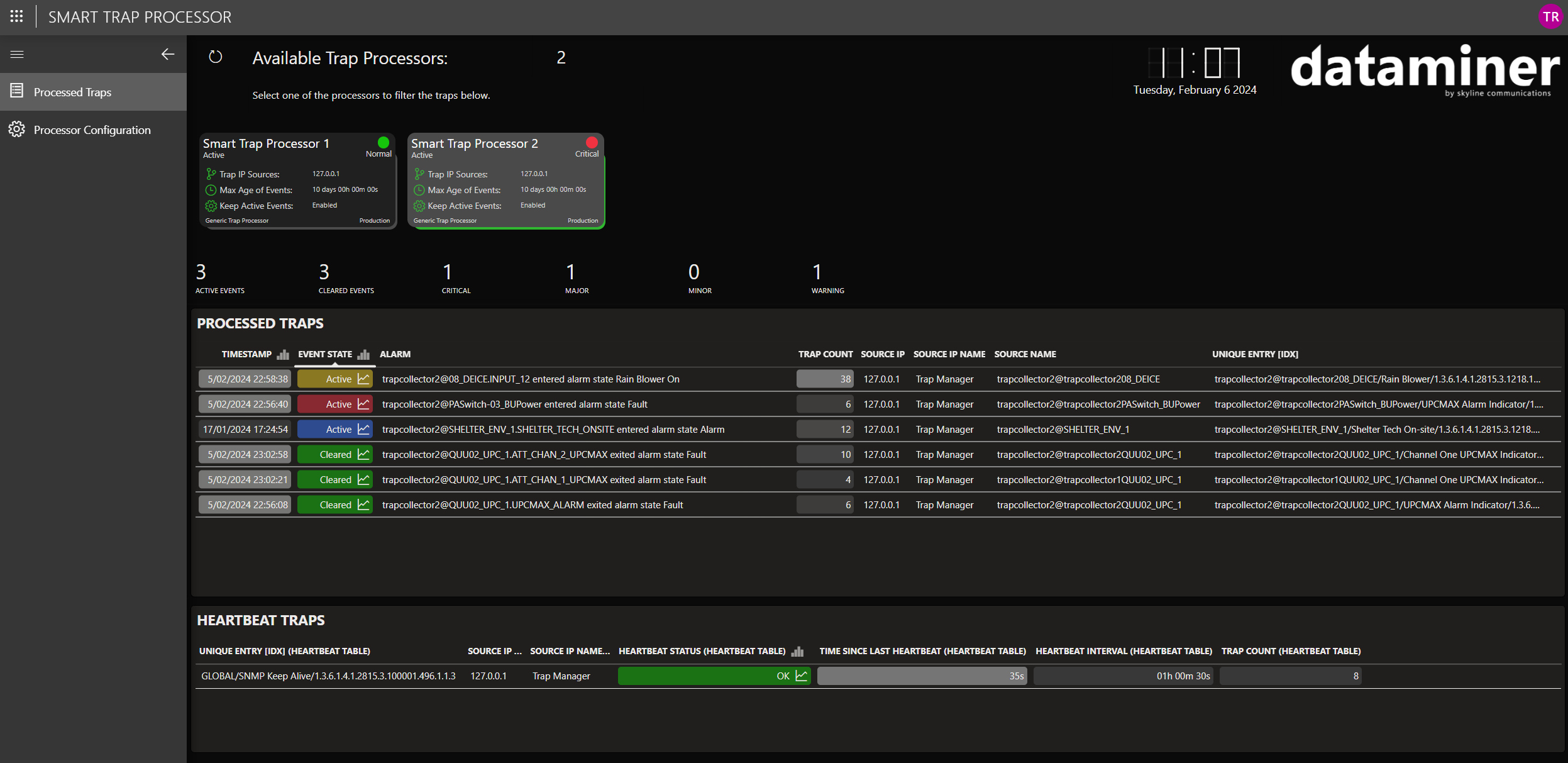 The Processed Traps page serves as a unified interface for monitoring SNMP traps from all processors in a DataMiner System. At the top of the page, the trap processor elements hosted on the DataMiner System are displayed. Below, trap events and heartbeats are shown. Additionally, a summary detailing the number of events corresponding to specific event statuses or alarm severities is provided.
The Processed Traps page serves as a unified interface for monitoring SNMP traps from all processors in a DataMiner System. At the top of the page, the trap processor elements hosted on the DataMiner System are displayed. Below, trap events and heartbeats are shown. Additionally, a summary detailing the number of events corresponding to specific event statuses or alarm severities is provided.
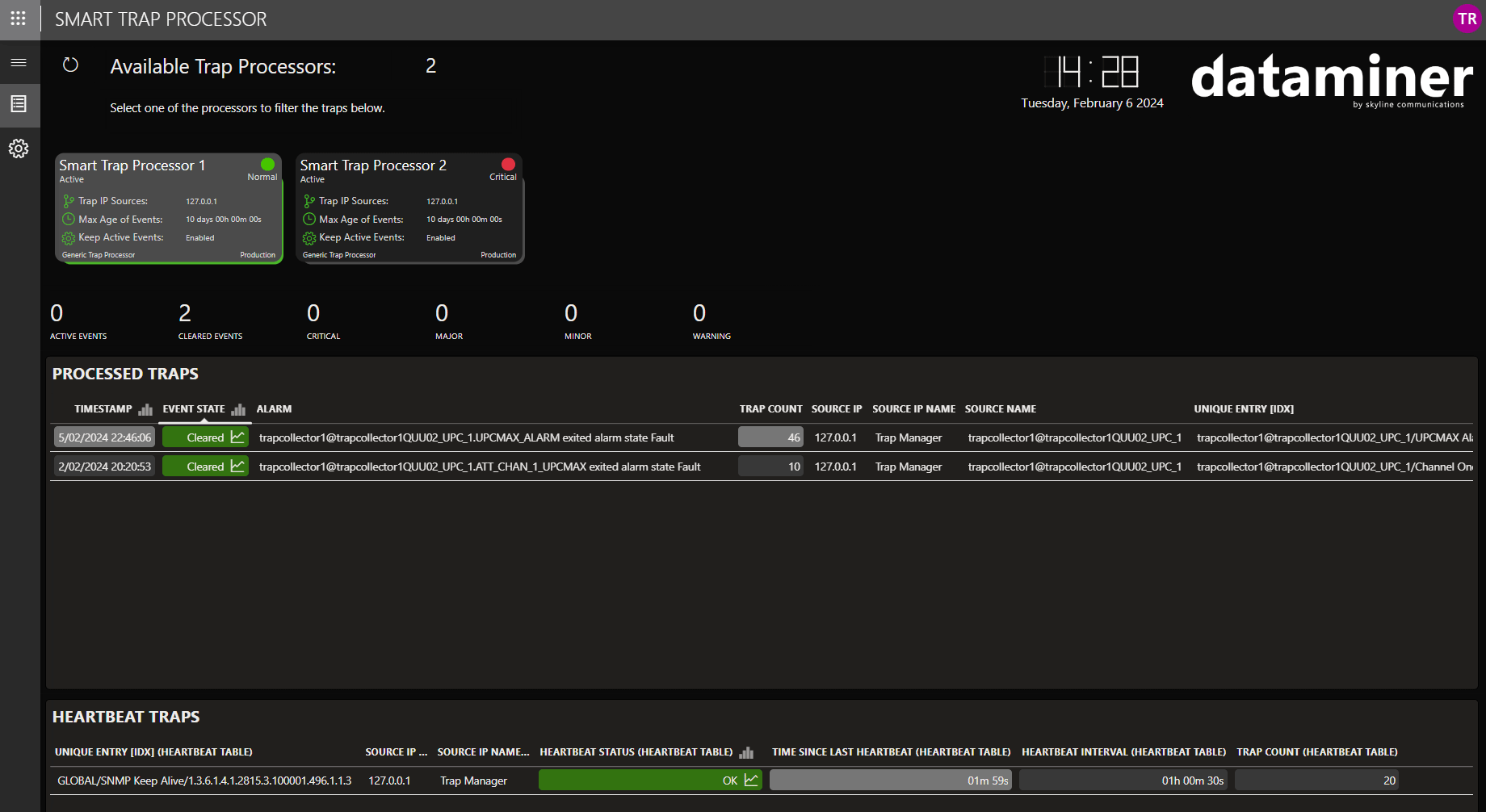 When a trap processor element is selected, the corresponding events and heartbeats are displayed below. For each processor, essential information such as the current alarm level, element state, count of active and cleared events, as well as the number of critical, major, minor, and warning alarms are provided for quick reference. Similarly, details for each trap include the latest timestamp, event state, alarm description, trap count, heartbeat status, and the time elapsed since the last heartbeat.
When a trap processor element is selected, the corresponding events and heartbeats are displayed below. For each processor, essential information such as the current alarm level, element state, count of active and cleared events, as well as the number of critical, major, minor, and warning alarms are provided for quick reference. Similarly, details for each trap include the latest timestamp, event state, alarm description, trap count, heartbeat status, and the time elapsed since the last heartbeat.
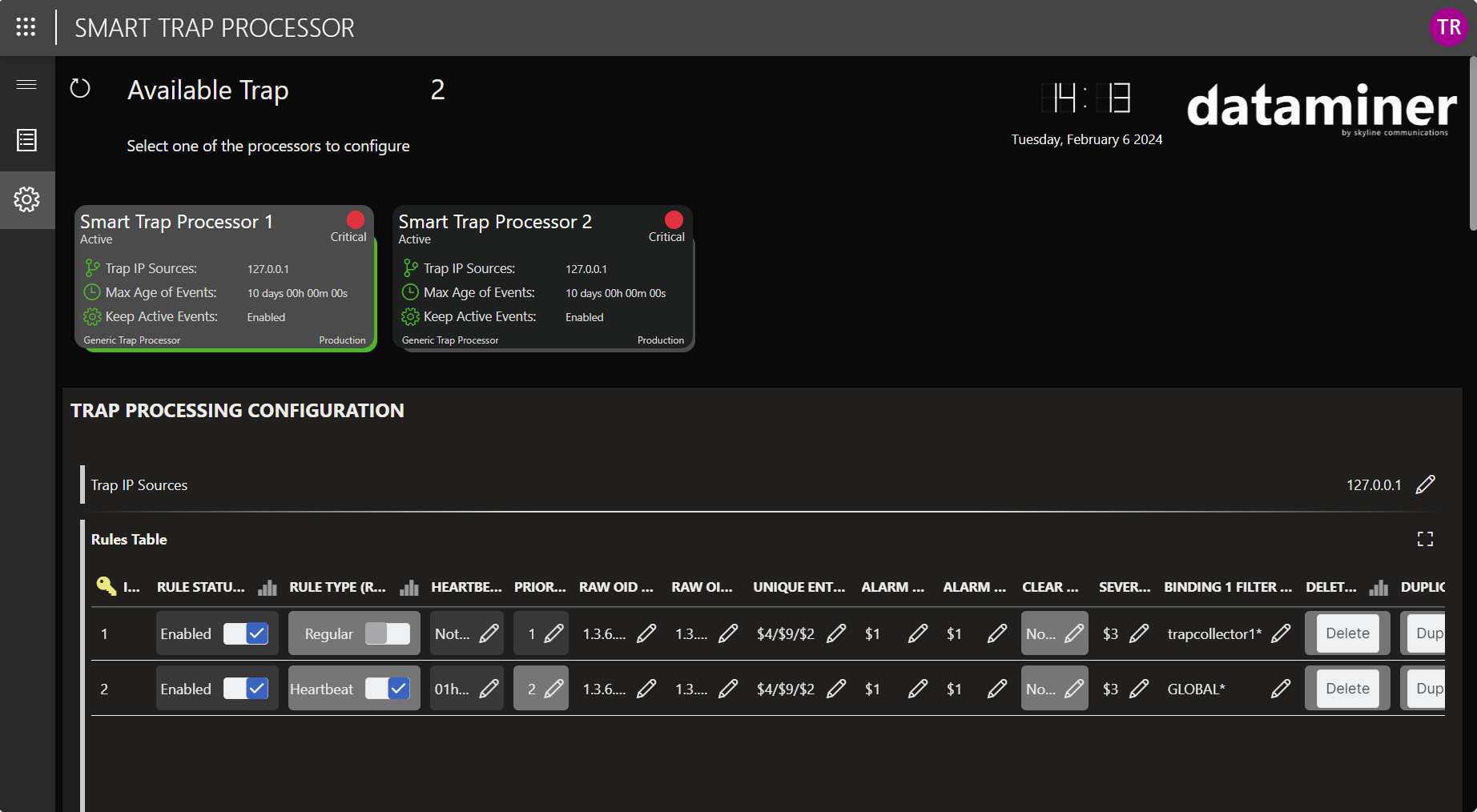 On the Processor Configuration page, you can fully configure each processor element within a DataMiner System. When you select a processor, you gain access to a range of options:
On the Processor Configuration page, you can fully configure each processor element within a DataMiner System. When you select a processor, you gain access to a range of options:- You can specify event source IPs.
- You can create event collection rules.
- You can define event source names for each trap.
- You can adjust auto-clear settings on a per-processor basis.
 The rules configured in this table dictate which traps are filtered from the source, determining which are displayed on the processed event tables. Set/Clear OIDs specified in this table establish the relationship between active and cleared traps for each event. Any data within the trap bindings can be used to determine which traps are processed and how they are ultimately displayed. When configuring rules for a trap processor, both heartbeat traps and regular event traps can be configured independently.
The rules configured in this table dictate which traps are filtered from the source, determining which are displayed on the processed event tables. Set/Clear OIDs specified in this table establish the relationship between active and cleared traps for each event. Any data within the trap bindings can be used to determine which traps are processed and how they are ultimately displayed. When configuring rules for a trap processor, both heartbeat traps and regular event traps can be configured independently.
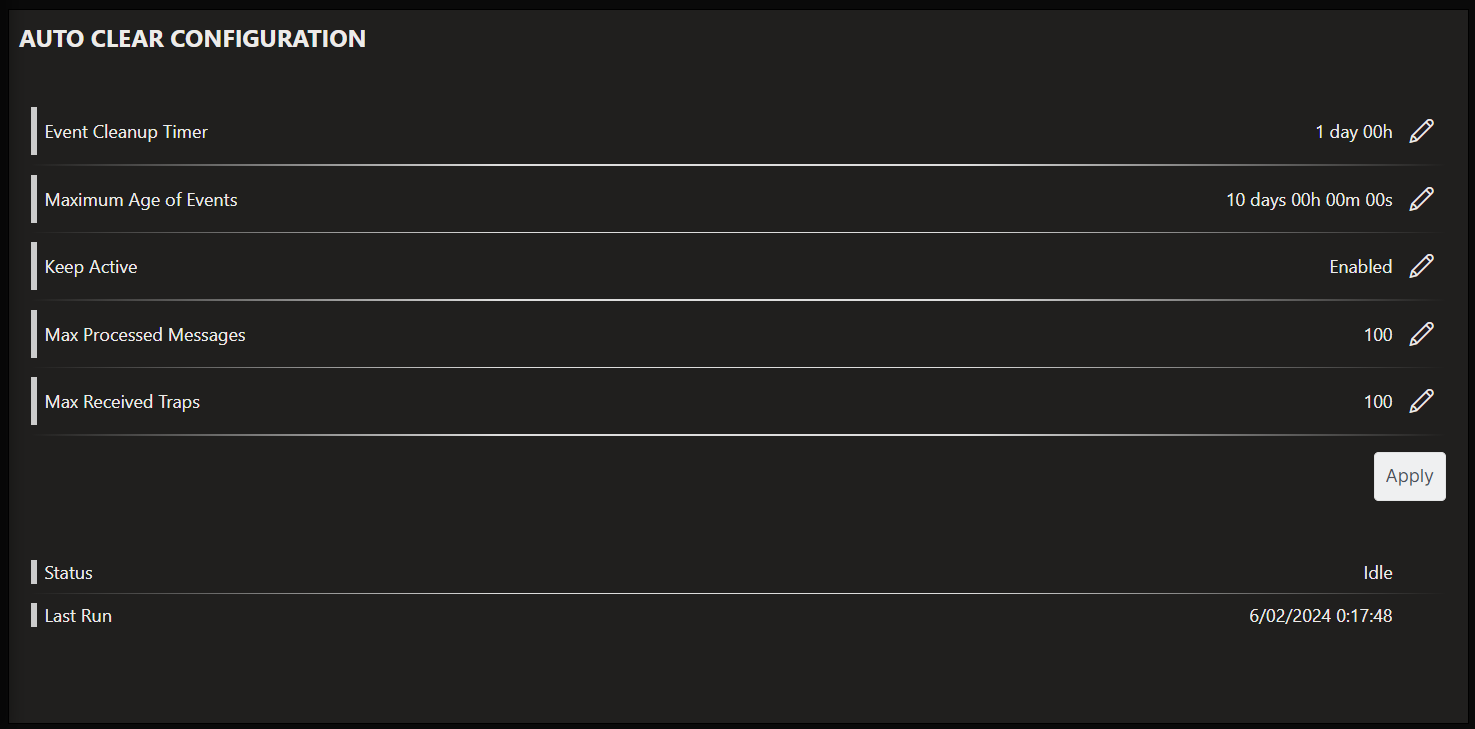 You can easily configure auto-clear settings for each trap processor. By defining parameters such as the maximum age of events and the interval for cleanup logic, you can maintain the cleanliness of the event monitoring interface. Additionally, the option to keep active events in the processed events table regardless of elapsed time ensures that long-lasting issues are not forgotten.
You can easily configure auto-clear settings for each trap processor. By defining parameters such as the maximum age of events and the interval for cleanup logic, you can maintain the cleanliness of the event monitoring interface. Additionally, the option to keep active events in the processed events table regardless of elapsed time ensures that long-lasting issues are not forgotten.
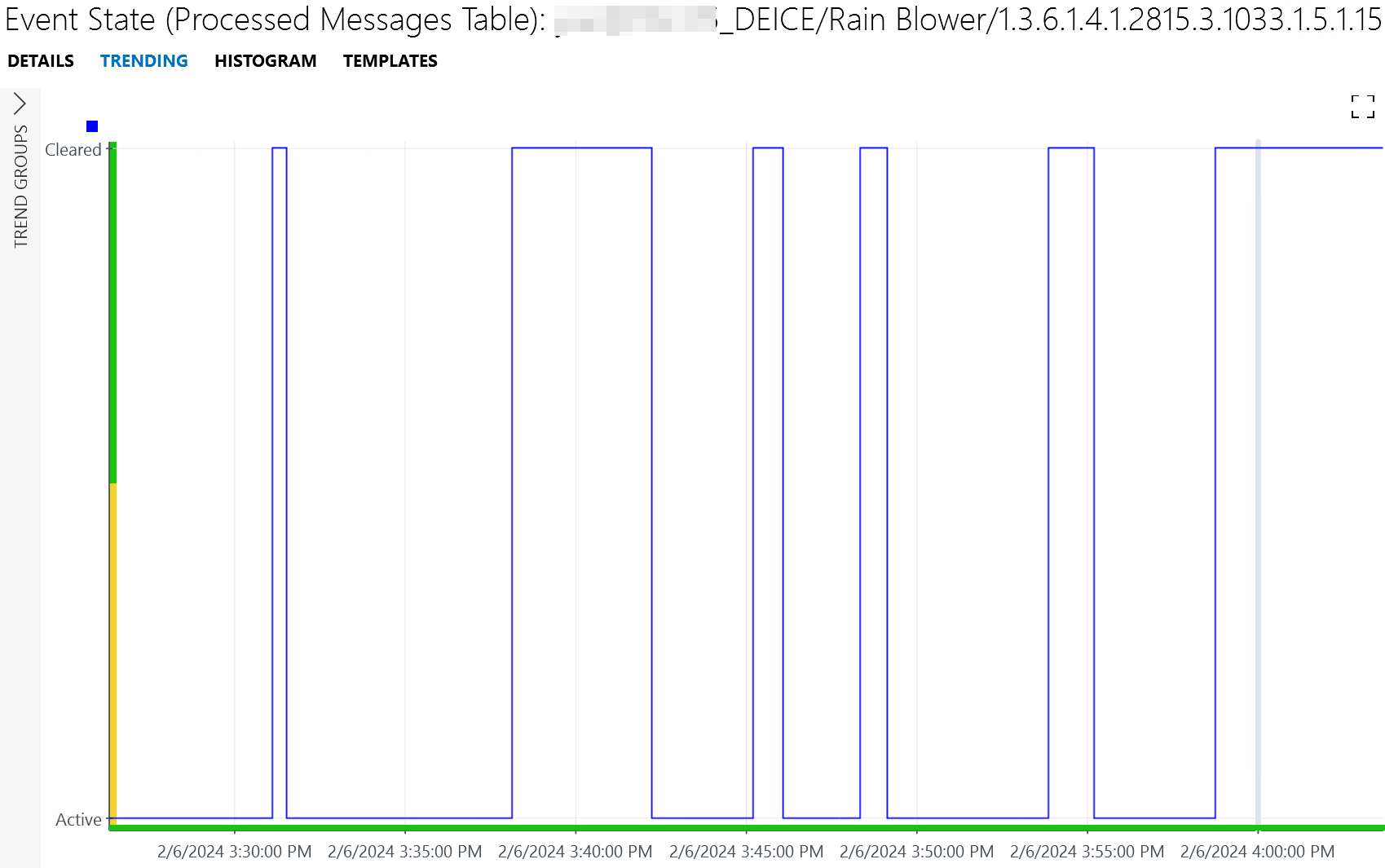 By enabling trending on the event state parameter for the processed traps, you can quickly get insights into the frequency and timing of specific events.
By enabling trending on the event state parameter for the processed traps, you can quickly get insights into the frequency and timing of specific events.
4 thoughts on “Smart Trap Processor”
Leave a Reply
You must be logged in to post a comment.
Nice implementation!
Great documentation as well Thomas 😉 Thanks also for sharing the link to deploy it via cloud.
Outstanding use case. Trap processing taken to the next level. Thank you!
Available in the demo system: https://ziine-ziine.on.dataminer.services/app/6e30f881-d9aa-4806-bfed-de5292a32d9e/Processed%20Traps